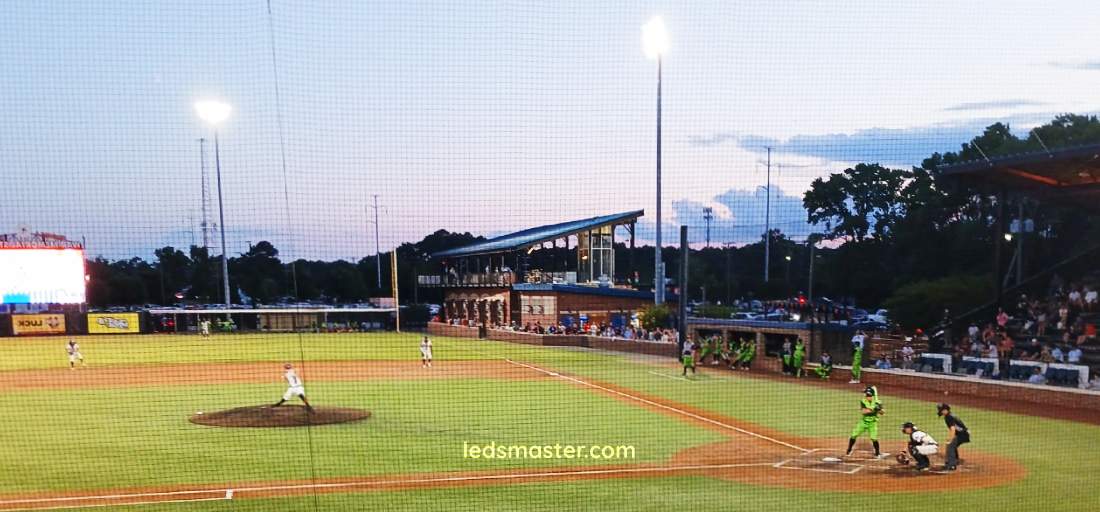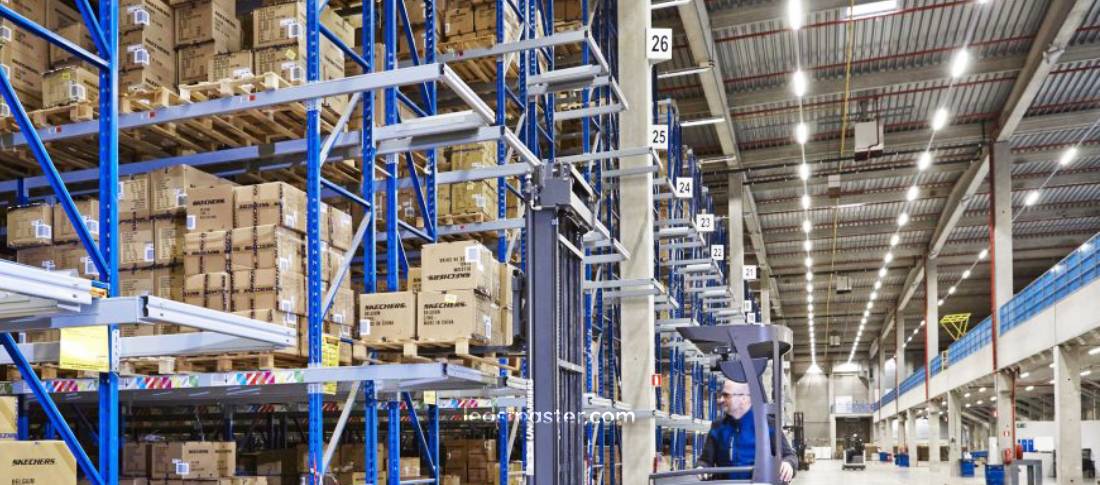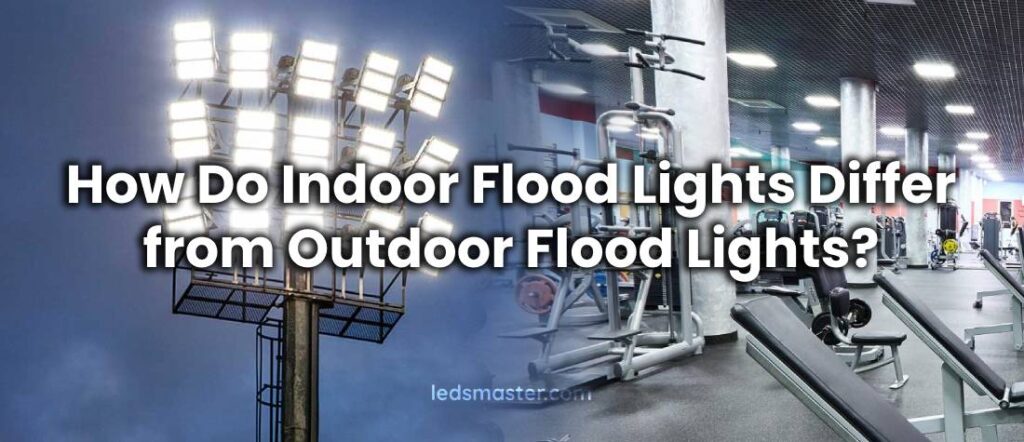Flood lights are versatile lighting solutions widely used in both indoor and outdoor environments. They provide broad, powerful illumination ideal for a variety of applications. However, indoor and outdoor flood lights serve different purposes and have unique requirements that influence their design and functionality. This article explores the distinctions between indoor and outdoor flood lights, focusing on aspects such as lighting requirements, effects, purposes, fixture types, and special features.
Table of Contents
ToggleLighting Requirements
Indoor Flood Lights
Indoor flood lights are designed to enhance visibility and create a well-lit environment within enclosed spaces. The primary lighting requirements for indoor flood lights are related to their ability to provide uniform illumination without causing excessive glare. Typically, indoor flood lights have a lower intensity compared to their outdoor counterparts, as indoor environments usually require less powerful lighting. The emphasis is on creating a comfortable and evenly distributed light that avoids harsh shadows or bright spots.
One crucial aspect of indoor flood lights is their color temperature. Indoor flood lights often use a color temperature between 2700K and 4000K, which produces a warm to neutral white light. This range is preferred for its ability to create a cozy and inviting atmosphere suitable for various indoor activities, from home settings to office spaces.
Outdoor Flood Lights
In contrast, outdoor flood lights must meet more demanding requirements due to their exposure to environmental elements and the need to cover larger areas. Outdoor flood lights are designed to withstand harsher conditions and provide high-intensity illumination to ensure safety and visibility in open spaces. They typically have higher lumen outputs to cover expansive areas effectively.
Outdoor flood lights usually feature a color temperature ranging from 4000K to 6000K, which produces a cooler, daylight-like light. This is ideal for outdoor applications where brighter, more focused lighting is necessary for security, navigation, or highlighting architectural features.

Lighting Effect
Indoor Flood Lights
The lighting effect of indoor flood lights is focused on creating a controlled and aesthetically pleasing ambiance. These lights are often used to highlight specific areas, such as artwork, plants, or architectural elements within a room. The goal is to provide sufficient illumination while enhancing the visual appeal of indoor spaces.
Indoor flood lights often feature adjustable beam angles, allowing users to direct light precisely where needed. This flexibility helps to minimize glare and ensure that the light is distributed evenly across the desired area. Additionally, indoor flood lights may incorporate dimming features to adjust the brightness according to different activities or moods.
Outdoor Flood Lights
Outdoor flood lights are designed to deliver a more intense and expansive lighting effect. Their primary function is to illuminate large areas effectively, such as driveways, parking lots, or building exteriors. The lighting effect is broader and more diffuse, aimed at enhancing visibility and security in outdoor environments.
Outdoor flood lights often come with features like wide beam angles and adjustable mounting options to cover large areas and different elevations. These lights are also designed to minimize light spill and glare, ensuring that the illumination is focused on the intended area without causing disturbances to neighboring properties.
Lighting Purposes
General Room Lighting
Indoor flood lights are frequently used as general room lighting, offering broad illumination that can fill a space with ample light. In a living room, for example, these lights can be strategically placed to provide even lighting across the room, eliminating dark spots and creating a welcoming ambiance. By positioning the lights to highlight architectural features, such as columns or textured walls, they can also enhance the room’s design elements.
Accent Lighting
Accent lighting is another common use for indoor flood lights. These fixtures are ideal for drawing attention to specific objects or areas within a room. In a gallery or museum, indoor flood lights can be directed to spotlight artwork, sculptures, or exhibits, making them stand out and adding a dramatic effect. Similarly, in a home setting, flood lights can be used to illuminate family photos or decorative items on shelves, creating focal points within the space.
Task Lighting
For tasks requiring focused illumination, indoor flood lights are particularly effective. In kitchens, for instance, these lights can be used to illuminate countertops and cooking areas, ensuring that there is adequate light for food preparation. They are also beneficial in workspaces, such as home offices or craft rooms, where precise lighting is necessary for detailed tasks. The ability to adjust the direction and intensity of the light allows users to customize the lighting according to their specific needs, enhancing both functionality and comfort.
Retail Environments
In retail settings, indoor flood lights play a crucial role in highlighting product displays and creating an engaging shopping experience. By directing light towards merchandise, these fixtures can make products more visible and attractive to customers. The adjustable nature of indoor flood lights allows retailers to spotlight specific items or promotional displays, drawing attention and encouraging purchases. Additionally, well-lit retail spaces contribute to a positive shopping environment, improving overall customer satisfaction.
Educational and Institutional Settings
Indoor flood lights are also used in educational and institutional settings to improve visibility and functionality. In libraries and study areas, they provide bright, focused lighting that supports reading and research activities. In museums and galleries, they help to showcase exhibits and artworks effectively, ensuring that details are visible while minimizing glare and shadows. The ability to adjust the angle and intensity of the light allows for precise control over the lighting environment, enhancing both usability and aesthetics.
Security and Safety
One of the primary functions of outdoor flood lights is to enhance security and safety. By illuminating driveways, parking lots, and building perimeters, these lights help to deter criminal activity and ensure that outdoor spaces are well-lit. The bright, even light provided by outdoor flood lights reduces shadows and dark areas where intruders might hide. This increased visibility contributes to a safer environment for residents, visitors, and employees.

Enhancing Visibility
Outdoor flood lights are crucial for improving visibility in various outdoor settings. Whether used in commercial properties, public spaces, or residential areas, these lights provide the necessary illumination for navigating pathways, entrances, and parking areas. They help prevent accidents by ensuring that all areas are clearly visible, even during low-light conditions or at night.
Decorative Lighting
In addition to their functional roles, outdoor flood lights are also used for decorative purposes. They can highlight architectural features of buildings, illuminate gardens, or accentuate outdoor landscaping elements such as fountains and statues. By creating dramatic lighting effects, outdoor flood lights enhance the visual appeal of outdoor spaces and contribute to a pleasant nighttime environment.
Durability and Weather Resistance
Given their exposure to the elements, outdoor flood lights are designed to be more durable and weather-resistant than indoor models. They are built to withstand extreme temperatures, moisture, and other environmental factors. Features such as weatherproof enclosures and corrosion-resistant materials ensure that these lights continue to function effectively despite challenging conditions. Additionally, some outdoor flood lights come with protective coatings to resist damage from rain, snow, and dust.
Optimal Placement and Height for Flood Lights
Indoor Flood Light Placement Flexibility
The flexibility of indoor flood light placement allows for a variety of configurations to achieve the desired lighting effect. These lights can be mounted on walls, ceilings, or even floors, based on the specific requirements of the space. The installation height is typically adapted to fit the dimensions of the room and the intended use of the lighting.
For instance, in expansive living areas, ceiling-mounted flood lights can provide broad, general illumination that fills the room. Conversely, in settings like galleries or showrooms, positioning flood lights closer to the floor can effectively highlight artworks or displays. The adjustability of these lights further enhances their utility, allowing users to direct light precisely where it is needed for optimal impact.
Outdoor Flood Light Installation Considerations
In outdoor settings, careful consideration of height and placement is essential due to environmental factors and the need to cover larger areas effectively. Outdoor flood lights are commonly mounted on poles or building walls at varying elevations to ensure comprehensive illumination.
The height of outdoor flood lights is determined by their intended purpose and the area they need to light. For example, flood lights in parking lots or expansive open areas are often installed on tall poles to provide extensive coverage and enhance visibility. In contrast, flood lights for residential security are typically mounted at lower heights to focus illumination on entryways and driveways, providing targeted lighting for safety and security.
Type of Fixtures
Recessed Fixtures
Recessed indoor flood lights are installed flush with the ceiling, creating a sleek and unobtrusive appearance. This type of fixture is ideal for maintaining a clean ceiling line and is particularly useful in modern interior designs where a minimalist look is desired. Recessed fixtures provide even, widespread illumination and are commonly used in living rooms, offices, and galleries.
Surface-Mounted Fixtures
Surface-mounted indoor flood lights are attached directly to the ceiling or wall, offering more flexibility in terms of placement. These fixtures are suitable for areas where the installation of recessed lights is not feasible or desired. Surface-mounted options are often used in spaces such as kitchens, retail environments, and studios, where adjustable lighting is needed to highlight specific areas or features.
Track-Mounted Fixtures
Track-mounted indoor flood lights consist of multiple fixtures attached to a single track, allowing for easy adjustment and repositioning. This type of setup is highly versatile and enables users to direct light to various areas of a room or display. Track-mounted flood lights are commonly used in galleries, showrooms, and other spaces where dynamic lighting and flexibility are important.
Wall-Mounted Fixtures
Wall-mounted outdoor flood lights are installed on building exteriors, providing illumination for entryways, pathways, and building perimeters. These fixtures are often used in residential and commercial settings to enhance security and visibility around structures. Wall-mounted lights are available in various styles, including those with integrated motion sensors for added security.
Pole-Mounted Fixtures
Pole-mounted outdoor flood lights are commonly used for larger areas such as parking lots, sports fields, and commercial properties. These fixtures are mounted on tall poles, allowing for extensive coverage and high visibility. Pole-mounted options are ideal for illuminating expansive spaces and are often designed to be adjustable to direct light as needed.
Weatherproof Enclosures
Outdoor flood lights with weatherproof enclosures are built to protect against harsh environmental conditions such as rain, dust, and extreme temperatures. These fixtures are equipped with robust enclosures that shield the internal components from the elements, ensuring long-lasting performance and reliability. Weatherproof flood lights are essential for maintaining illumination and functionality in challenging outdoor environments.

Special Features
Anti-Glare Technology
One of the essential features of indoor flood lights is anti-glare technology. This feature minimizes the harshness of direct light, reducing visual discomfort and eye strain. By diffusing the light or using specialized lenses, indoor flood lights create a softer, more pleasant illumination that enhances visual comfort, especially in settings where people spend extended periods.
Dimming Capabilities
Another significant feature is dimming capability, which allows users to adjust the brightness levels according to their needs and preferences. Whether for a cozy evening at home or a brightly lit workspace, the ability to control light intensity helps create the perfect ambiance and supports various activities. This flexibility is particularly useful in areas like living rooms, where lighting needs can vary throughout the day.
Uniform Light Distribution
Uniformity in light distribution is crucial for indoor flood lights. These lights are designed to provide even illumination across the space, which helps to minimize shadows and reduce the occurrence of bright spots. This ensures a balanced and consistent lighting environment, enhancing overall visual comfort and effectiveness. Uniform lighting is particularly important in areas such as offices and galleries, where even light coverage improves visibility and aesthetics.
Shock-Proof and Weather-Resistant Designs
Outdoor flood lights are engineered to be shock-proof and weather-resistant, addressing the impact of environmental factors. These designs ensure that the lights can withstand physical impacts, extreme temperatures, and moisture. Durable housings and rugged construction protect the lights from damage caused by rain, snow, wind, and other weather conditions, ensuring long-lasting performance.
Anti-Corrosion Coatings
Many outdoor flood lights are equipped with anti-corrosion coatings to prevent damage from rain and humidity. These coatings are essential for maintaining the structural integrity and appearance of the lights over time. By preventing rust and corrosion, these coatings extend the lifespan of the fixtures and ensure they continue to perform effectively in harsh outdoor conditions.
Motion Sensors and Timers
Incorporating motion sensors and timers adds a layer of functionality to outdoor flood lights. Motion sensors detect movement and activate the lights only when needed, which enhances security and reduces energy consumption. Timers allow users to set specific operating times for the lights, optimizing energy use and providing convenience. For instance, motion sensors can be used in security lighting to illuminate areas when someone approaches, while timers can be set for lights to operate during specific hours of the night.
Conclusion
Indoor and outdoor flood lights are designed to meet different needs, influencing their overall design and functionality. Indoor flood lights aim to enhance comfort and aesthetics by providing uniform illumination and adjustable features, creating a pleasant environment. In contrast, outdoor flood lights are built to endure harsh weather conditions and deliver high-intensity lighting for security, safety, and visibility. Understanding these distinctions helps in choosing the right type of flood light for each application, ensuring both effective lighting and optimal performance. By considering factors such as lighting intensity, fixture types, and special features, users can make informed choices to achieve their desired lighting outcomes.

